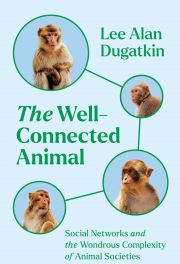The Well-Connected Animal

Lee Alan Dugatkin
University of Chicago Press, £19.99
Lee Alan Dugatkin has produced a book about the social networks of non-human animals, which are far more complex than initially thought. For example, there’s an assumption that female animals choose a mate according to the genetic strength of a partner – Dugatkin’s observations suggest there is more to it than good genes alone.
The book covers numerous networks that exist within a species’ social arrangement. For example, the safety network of barn-living mice in Switzerland. Here, none of the 400-plus mice were caged or restricted and the barn was predator-proof. Or so they thought. The barn was a magnet for cats, who finally managed to break in and wreak havoc on the mouse population. This enabled the study of how the deadly event affected the social network of the remaining mice. Researchers found that those who had few social connections prior to the event formed new ones, while mice who had been well connected strengthened their connections with those who had survived. Thus, a safety network will form when disaster strikes.
Culture networks are also examined, looking at work dating from the 1950s on a Japanese macaque who demonstrated tool use by washing sweet potatoes in sea water to remove sand. This macaque’s skills were eventually passed on to fellow macaques. It has taken until recently for this work to be recognised as an example of social network theory.
With an extensive reference list and colour images and diagrams, The Well-Connected Animal should be a go-to text for undergraduates and budding behaviourists who want to make a difference in changing attitudes toward the non-human animal.
Pat Sang CBiol MRSB
Reviewed by Pat Sang CBiol MRSB, managing director of Animal Biology and Care Education Ltd


